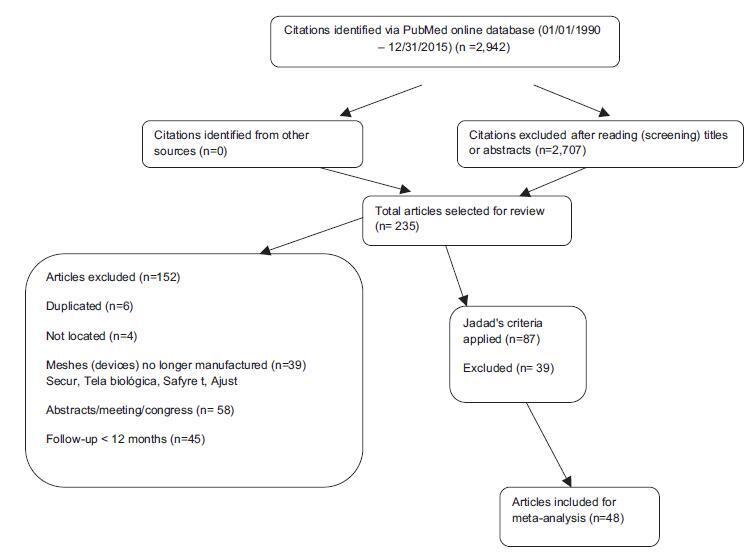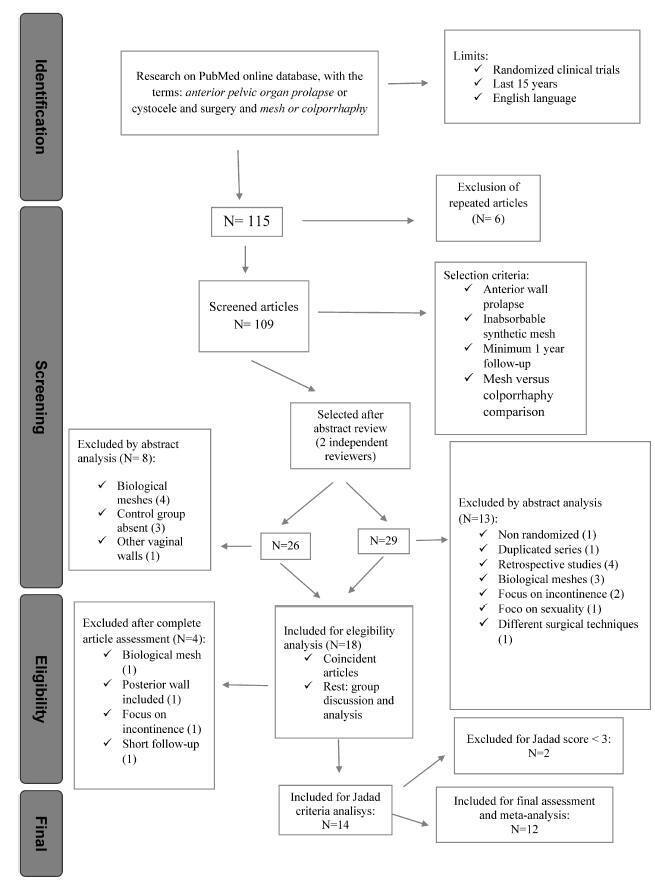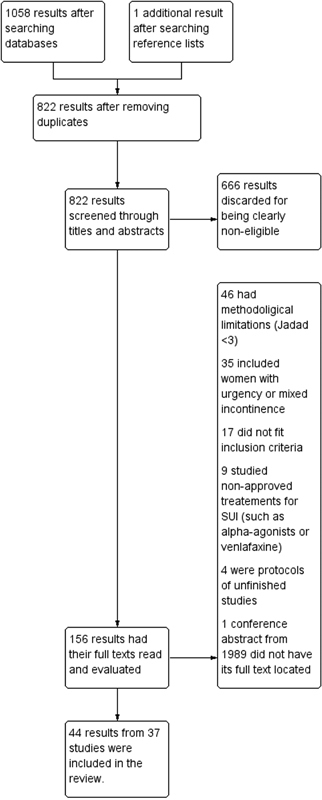-
Review Article
Surgical Treatment for Stress Urinary Incontinence in Women: A Systematic Review and Meta-analysis
- Letícia Maria de Oliveira,
- Marcia Maria Dias,
- Sérgio Brasileiro Martins,
- Jorge Milhem Haddad,
- Manoel João Batista Castello Girão, [ ... ],
- Rodrigo de Aquino Castro
08-01-2018
Summary
Review ArticleSurgical Treatment for Stress Urinary Incontinence in Women: A Systematic Review and Meta-analysis
Revista Brasileira de Ginecologia e Obstetrícia. 2018;40(8):477-490
08-01-2018- Letícia Maria de Oliveira,
- Marcia Maria Dias,
- Sérgio Brasileiro Martins,
- Jorge Milhem Haddad,
- Manoel João Batista Castello Girão,
- Rodrigo de Aquino Castro
Views159See moreAbstract
Objective
To compare surgical treatments for stress urinary incontinence in terms of efficiency and complications.
Data Sources
We searched the MEDLINE and COCHRANE databases using the terms stress urinary incontinence, surgical treatment for stress urinary incontinence and sling. Selection of Studies Forty-eight studies were selected, which amounted to a total of 6,881 patients with scores equal to or higher than 3 in the Jadad scale.
Data Collection
Each study was read by one of the authors, added to a standardized table and checked by a second author. We extracted data on intervention details, follow-up time, the results of treatment and adverse events.
Data Synthesis
Comparing retropubic versus transobturator slings, the former was superior for both objective (odds ratio [OR], 1.27; 95% confidence interval [CI], 1.05-1.54) and subjective (OR, 1.23; 95% CI, 1.02-1.48) cures. Between minislings versus other slings, there was a difference favoring other slings for subjective cure (OR, 0.58; 95% CI, 0.39- 0.86). Between pubovaginal sling versus Burch surgery, there was a difference for both objective (OR, 2.04; 95% CI, 1.50-2.77) and subjective (OR, 1.64; 95% CI, 1.10-2.44) cures, favoring pubovaginal sling. Therewas no difference in the groups: midurethral slings versus Burch, pubovaginal sling versus midurethral slings, transobturator slings, minislings versus other slings (objective cure). Retropubic and pubovaginal slings are more retentionist. Retropubic slings have more bladder perforation, and transobturator slings, more leg and groin pain, neurological lesion and vaginal perforation.
Conclusion
Pubovaginal slings are superior to Burch colposuspension surgery but exhibit more retention. Retropubic slings are superior to transobturator slings, with more adverse events. Other slings are superior to minislings in the subjective aspect. There was no difference in the comparisons between midurethral slings versus Burch colposuspension surgery, pubovaginal versus midurethral slings, and inside-out versus outside-in transobturator slings.
Views159

This is an Open Access article distributed under the terms of the Creative Commons Attribution License, which permits unrestricted use, distribution, and reproduction in any medium, provided the original work is properly cited. Summary
Review ArticleSurgical Treatment for Stress Urinary Incontinence in Women: A Systematic Review and Meta-analysis
Revista Brasileira de Ginecologia e Obstetrícia. 2018;40(8):477-490
08-01-2018- Letícia Maria de Oliveira,
- Marcia Maria Dias,
- Sérgio Brasileiro Martins,
- Jorge Milhem Haddad,
- Manoel João Batista Castello Girão,
- Rodrigo de Aquino Castro
Views159See moreAbstract
Objective
To compare surgical treatments for stress urinary incontinence in terms of efficiency and complications.
Data Sources
We searched the MEDLINE and COCHRANE databases using the terms stress urinary incontinence, surgical treatment for stress urinary incontinence and sling. Selection of Studies Forty-eight studies were selected, which amounted to a total of 6,881 patients with scores equal to or higher than 3 in the Jadad scale.
Data Collection
Each study was read by one of the authors, added to a standardized table and checked by a second author. We extracted data on intervention details, follow-up time, the results of treatment and adverse events.
Data Synthesis
Comparing retropubic versus transobturator slings, the former was superior for both objective (odds ratio [OR], 1.27; 95% confidence interval [CI], 1.05-1.54) and subjective (OR, 1.23; 95% CI, 1.02-1.48) cures. Between minislings versus other slings, there was a difference favoring other slings for subjective cure (OR, 0.58; 95% CI, 0.39- 0.86). Between pubovaginal sling versus Burch surgery, there was a difference for both objective (OR, 2.04; 95% CI, 1.50-2.77) and subjective (OR, 1.64; 95% CI, 1.10-2.44) cures, favoring pubovaginal sling. Therewas no difference in the groups: midurethral slings versus Burch, pubovaginal sling versus midurethral slings, transobturator slings, minislings versus other slings (objective cure). Retropubic and pubovaginal slings are more retentionist. Retropubic slings have more bladder perforation, and transobturator slings, more leg and groin pain, neurological lesion and vaginal perforation.
Conclusion
Pubovaginal slings are superior to Burch colposuspension surgery but exhibit more retention. Retropubic slings are superior to transobturator slings, with more adverse events. Other slings are superior to minislings in the subjective aspect. There was no difference in the comparisons between midurethral slings versus Burch colposuspension surgery, pubovaginal versus midurethral slings, and inside-out versus outside-in transobturator slings.


This is an Open Access article distributed under the terms of the Creative Commons Attribution License, which permits unrestricted use, distribution, and reproduction in any medium, provided the original work is properly cited. 
-
Review Article
Mesh Surgery for Anterior Vaginal Wall Prolapse: A Meta-analysis
- Cássia Raquel Teatin Juliato,
- Luiz Carlos do Santos Júnior,
- Jorge Milhem Haddad,
- Rodrigo Aquino Castro,
- Marcelo Lima1 Edilson Benedito de Castro
07-01-2016
Summary
Review ArticleMesh Surgery for Anterior Vaginal Wall Prolapse: A Meta-analysis
Revista Brasileira de Ginecologia e Obstetrícia. 2016;38(7):356-364
07-01-2016- Cássia Raquel Teatin Juliato,
- Luiz Carlos do Santos Júnior,
- Jorge Milhem Haddad,
- Rodrigo Aquino Castro,
- Marcelo Lima1 Edilson Benedito de Castro
Views151See moreAbstract
Purpose
Pelvic organ prolapse (POP) is a major health issue worldwide, affecting 6- 8% of women. The most affected site is the anterior vaginal wall. Multiple procedures and surgical techniques have been used,with or without the use of vaginalmeshes, due to common treatment failure, reoperations, and complication rates in some studies.
Methods
Systematic review of the literature and meta-analysis regarding the use of vaginal mesh in anterior vaginal wall prolapse was performed. A total of 115 papers were retrieved after using the medical subject headings (MESH) terms: 'anterior pelvic organ prolapse OR cystocele AND surgery AND (mesh or colporrhaphy)' in the PubMed database. Exclusion criteria were: follow-up shorter than 1 year, use of biological or absorbable meshes, and inclusion of other vaginal wall prolapses. Studies were put in a data chart by two independent editors; results found in at least two studies were grouped for analysis.
Results
After the review of the titles by two independent editors, 70 studies were discarded, and after abstract assessment, 18 trials were eligible for full text screening. For final screening and meta-analysis, after applying the Jadad score (> 2), 12 studies were included. Objective cure was greater in the mesh surgery group (odds ratio [OR] = 1,28 [1,07-1,53]), which also had greater blood loss (mean deviation [MD] = 45,98 [9,72-82,25]), longer surgery time (MD = 15,08 [0,48-29,67]), but less prolapse recurrence (OR = 0,22 [01,3-0,38]). Dyspareunia, symptom resolution and reoperation rates were not statistically different between groups. Quality of life (QOL) assessment through the pelvic organ prolapse/urinary incontinence sexual questionnaire (PISQ-12), the pelvic floor distress inventory (PFDI-20), the pelvic floor impact questionnaire (PFIQ-7), and the perceived quality of life scale (PQOL) was not significantly different.
Conclusions
Anterior vaginal prolapse mesh surgery has greater anatomic cure rates and less recurrence, although there were no differences regarding subjective cure, reoperation rates and quality of life. Furthermore, mesh surgery was associated with longer surgical time and greater blood loss. Mesh use should be individualized, considering prior history and risk factors for recurrence.
Views151

This is an Open Access article distributed under the terms of the Creative Commons Attribution License, which permits unrestricted use, distribution, and reproduction in any medium, provided the original work is properly cited. Summary
Review ArticleMesh Surgery for Anterior Vaginal Wall Prolapse: A Meta-analysis
Revista Brasileira de Ginecologia e Obstetrícia. 2016;38(7):356-364
07-01-2016- Cássia Raquel Teatin Juliato,
- Luiz Carlos do Santos Júnior,
- Jorge Milhem Haddad,
- Rodrigo Aquino Castro,
- Marcelo Lima1 Edilson Benedito de Castro
Views151See moreAbstract
Purpose
Pelvic organ prolapse (POP) is a major health issue worldwide, affecting 6- 8% of women. The most affected site is the anterior vaginal wall. Multiple procedures and surgical techniques have been used,with or without the use of vaginalmeshes, due to common treatment failure, reoperations, and complication rates in some studies.
Methods
Systematic review of the literature and meta-analysis regarding the use of vaginal mesh in anterior vaginal wall prolapse was performed. A total of 115 papers were retrieved after using the medical subject headings (MESH) terms: 'anterior pelvic organ prolapse OR cystocele AND surgery AND (mesh or colporrhaphy)' in the PubMed database. Exclusion criteria were: follow-up shorter than 1 year, use of biological or absorbable meshes, and inclusion of other vaginal wall prolapses. Studies were put in a data chart by two independent editors; results found in at least two studies were grouped for analysis.
Results
After the review of the titles by two independent editors, 70 studies were discarded, and after abstract assessment, 18 trials were eligible for full text screening. For final screening and meta-analysis, after applying the Jadad score (> 2), 12 studies were included. Objective cure was greater in the mesh surgery group (odds ratio [OR] = 1,28 [1,07-1,53]), which also had greater blood loss (mean deviation [MD] = 45,98 [9,72-82,25]), longer surgery time (MD = 15,08 [0,48-29,67]), but less prolapse recurrence (OR = 0,22 [01,3-0,38]). Dyspareunia, symptom resolution and reoperation rates were not statistically different between groups. Quality of life (QOL) assessment through the pelvic organ prolapse/urinary incontinence sexual questionnaire (PISQ-12), the pelvic floor distress inventory (PFDI-20), the pelvic floor impact questionnaire (PFIQ-7), and the perceived quality of life scale (PQOL) was not significantly different.
Conclusions
Anterior vaginal prolapse mesh surgery has greater anatomic cure rates and less recurrence, although there were no differences regarding subjective cure, reoperation rates and quality of life. Furthermore, mesh surgery was associated with longer surgical time and greater blood loss. Mesh use should be individualized, considering prior history and risk factors for recurrence.


This is an Open Access article distributed under the terms of the Creative Commons Attribution License, which permits unrestricted use, distribution, and reproduction in any medium, provided the original work is properly cited. 
-
Review Article
Conservative Treatment of Stress Urinary Incontinence: A Systematic Review with Meta-analysis of Randomized Controlled Trials
- Rafael Mendes Moroni,
- Pedro Sergio Magnani,
- Jorge Milhem Haddad,
- Rodrigo de Aquino Castro,
- Luiz Gustavo Oliveira Brito
02-01-2016
Summary
Review ArticleConservative Treatment of Stress Urinary Incontinence: A Systematic Review with Meta-analysis of Randomized Controlled Trials
Revista Brasileira de Ginecologia e Obstetrícia. 2016;38(2):97-111
02-01-2016- Rafael Mendes Moroni,
- Pedro Sergio Magnani,
- Jorge Milhem Haddad,
- Rodrigo de Aquino Castro,
- Luiz Gustavo Oliveira Brito
Views217See moreWe performed a systematic review and meta-analysis of randomized controlled trials that studied the conservative management of stress urinary incontinence (SUI). There were 1058 results after the initial searches, from which 37 studies were eligible according to previously determined inclusion criteria. For the primary outcomes, pelvic floor muscle training (PFMT) was more efficacious than no treatment in improving incontinence-specific quality of life (QoL) scales (SMD = [1]1.24SDs; CI 95% = [1]1.77 to [1]0.71SDs). However, its effect on pad tests was imprecise. Combining biofeedback with PFMT had an uncertain effect on QoL (MD = [1]4.4 points; CI 95% = [1]16.69 to 7.89 points), but better results on the pad test, although with elevated heterogeneity (MD = 0.9g; 95%CI = 0.71 to 1,10g); group PFMT was not less efficacious than individual treatment, and home PFMT was not consistently worse than supervised PFMT. Both intravaginal and superficial electrical stimulation (IES and SES) were better than no treatment for QoL and pad test. Vaginal cones had mixed results. The association of IES with PFMT may improve the efficacy of the latter for QoL and pad test, but the results of individual studies were not consistent. Thus, there is evidence of the use of PFMT on the treatment of SUI, with and without biofeedback.
Views217

This is an Open Access article distributed under the terms of the Creative Commons Attribution License, which permits unrestricted use, distribution, and reproduction in any medium, provided the original work is properly cited. Summary
Review ArticleConservative Treatment of Stress Urinary Incontinence: A Systematic Review with Meta-analysis of Randomized Controlled Trials
Revista Brasileira de Ginecologia e Obstetrícia. 2016;38(2):97-111
02-01-2016- Rafael Mendes Moroni,
- Pedro Sergio Magnani,
- Jorge Milhem Haddad,
- Rodrigo de Aquino Castro,
- Luiz Gustavo Oliveira Brito
Views217See moreWe performed a systematic review and meta-analysis of randomized controlled trials that studied the conservative management of stress urinary incontinence (SUI). There were 1058 results after the initial searches, from which 37 studies were eligible according to previously determined inclusion criteria. For the primary outcomes, pelvic floor muscle training (PFMT) was more efficacious than no treatment in improving incontinence-specific quality of life (QoL) scales (SMD = [1]1.24SDs; CI 95% = [1]1.77 to [1]0.71SDs). However, its effect on pad tests was imprecise. Combining biofeedback with PFMT had an uncertain effect on QoL (MD = [1]4.4 points; CI 95% = [1]16.69 to 7.89 points), but better results on the pad test, although with elevated heterogeneity (MD = 0.9g; 95%CI = 0.71 to 1,10g); group PFMT was not less efficacious than individual treatment, and home PFMT was not consistently worse than supervised PFMT. Both intravaginal and superficial electrical stimulation (IES and SES) were better than no treatment for QoL and pad test. Vaginal cones had mixed results. The association of IES with PFMT may improve the efficacy of the latter for QoL and pad test, but the results of individual studies were not consistent. Thus, there is evidence of the use of PFMT on the treatment of SUI, with and without biofeedback.


This is an Open Access article distributed under the terms of the Creative Commons Attribution License, which permits unrestricted use, distribution, and reproduction in any medium, provided the original work is properly cited. 
-
Resumo De Tese
Add-back therapy with GnRH analogues in the treatment of uterine leiomyomata: systematic review and meta-analysis of randomized controlled trials
Revista Brasileira de Ginecologia e Obstetrícia. 2014;36(6):281-281
06-01-2014
Summary
Resumo De TeseAdd-back therapy with GnRH analogues in the treatment of uterine leiomyomata: systematic review and meta-analysis of randomized controlled trials
Revista Brasileira de Ginecologia e Obstetrícia. 2014;36(6):281-281
06-01-2014Views50

This is an Open Access article distributed under the terms of the Creative Commons Attribution License, which permits unrestricted use, distribution, and reproduction in any medium, provided the original work is properly cited. Summary
Resumo De TeseAdd-back therapy with GnRH analogues in the treatment of uterine leiomyomata: systematic review and meta-analysis of randomized controlled trials
Revista Brasileira de Ginecologia e Obstetrícia. 2014;36(6):281-281
06-01-2014

This is an Open Access article distributed under the terms of the Creative Commons Attribution License, which permits unrestricted use, distribution, and reproduction in any medium, provided the original work is properly cited.
Search
Search in:
